动词第三人称单数变化规则
英语动词第三人称单数变化规则

英语动词第三人称单数变化规则一般现在时的肯定句中,主语为第三人称单数的动词变化主要体现在词尾的变化上,其规律为:规则原形第三人称单数形式 1、一般情况下,直接在动词词尾+s如:get take play gets takes plays2、以s, x, sh, ch, o结尾的动词,在词尾+ esguess fix finish teach go和do guesses fixes finishes teaches goes和does3、以辅音字母+ y 结尾的动词,先把y变为i,再加esstudy try fly carry worrystudies tries flies carries worries4、不规则动词(特殊情况)have behas is1、变否定句:含有动词第三人称单数形式的句子变否定句时,要在动词前面加上doesn’t 或does not,动词的第三人称单数形式要还原成原形:格式为doesn’t/does not + 动词原形,如: He goes to school at six in the morning. (变否定句)→He doesn’t go to school at six in the morning。
2、变一般疑问句:把含有动词第三人称单数形式的变成一般疑问句时,要借用助动词does,如:She goes home at five every day。
→Does she go home at five every day?—-- Yes, she does。
/No, she doesn’t。
哪些主语是第三人称单数? 1、人称代词he, she, it;如:He likes watching TV. 他喜欢看电视。
She has lunch at twelve。
她十二点吃午餐. It looks like a cat。
它看起来像只猫.2、单个人名、地名或称呼作主语;是第三人称单数.如:Han Mei looks like her mother. 韩梅看起来像她的母亲。
(完整)动词第三人称单数变化规则如下
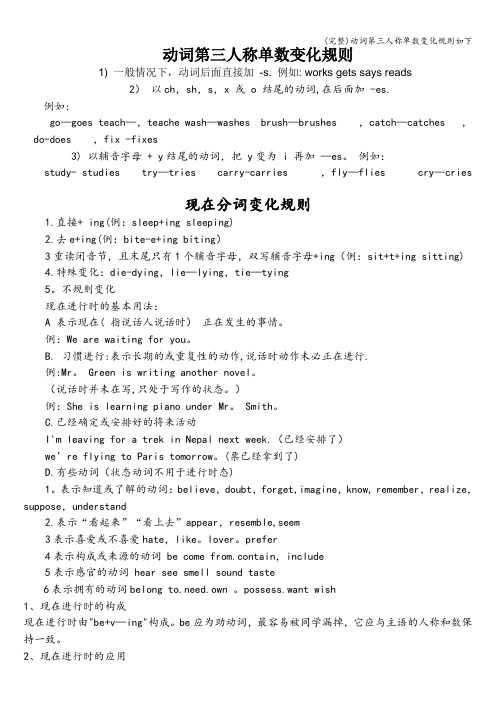
动词第三人称单数变化规则1) 一般情况下,动词后面直接加-s. 例如: works gets says reads2)以ch,sh,s,x 或 o 结尾的动词,在后面加 -es.例如:go—goes teach—,teache wash—washes brush—brushes ,catch—catches ,do-does ,fix -fixes3) 以辅音字母 + y结尾的动词,把 y变为 i 再加—es。
例如:study- studies try—tries carry-carries ,fly—flies cry—cries现在分词变化规则1.直接+ ing(例:sleep+ing sleeping)2.去e+ing(例:bite-e+ing biting)3重读闭音节,且末尾只有1个辅音字母,双写辅音字母+ing(例:sit+t+ing sitting)4.特殊变化:die-dying,lie—lying,tie—tying5。
不规则变化现在进行时的基本用法:A 表示现在( 指说话人说话时)正在发生的事情。
例:We are waiting for you。
B. 习惯进行:表示长期的或重复性的动作,说话时动作未必正在进行.例:Mr。
Green is writing another novel。
(说话时并未在写,只处于写作的状态。
)例:She is learning piano under Mr。
Smith。
C.已经确定或安排好的将来活动I'm leaving for a trek in Nepal next week.(已经安排了)we’re flying to Paris tomorrow。
(票已经拿到了)D.有些动词(状态动词不用于进行时态)1。
表示知道或了解的动词:believe,doubt,forget,imagine,know, remember,realize,suppose,understand2.表示“看起来”“看上去”appear,resemble,seem3表示喜爱或不喜爱hate,like。
英语动词第三人称单数变化规则

英语动词第三人称单数变化规则一般现在时的肯定句中,主语为第三人称单数的动词变化主要体现在词尾的变化上,其规律为:规则原形第三人称单数形式 1、一般情况下,直接在动词词尾+s如:get take play gets takes plays2、以s, x, sh, ch, o结尾的动词,在词尾+ esguess fix finish teach go和do guesses fixes finishes teaches goes和does3、以辅音字母+ y 结尾的动词,先把y变为i,再加esstudy try fly carry worrystudies tries flies carries worries4、不规则动词(特殊情况)have behas is1、变否定句:含有动词第三人称单数形式的句子变否定句时,要在动词前面加上doesn’t 或does not,动词的第三人称单数形式要还原成原形:格式为doesn’t/does not + 动词原形,如:He goes to school at six in the morning. (变否定句) →He doesn't go to school at six in the morning.2、变一般疑问句:把含有动词第三人称单数形式的变成一般疑问句时,要借用助动词does,如:She goes home at five every day. →Does she go home at five every day? --- Yes, she does./No, she doesn’t.哪些主语是第三人称单数? 1、人称代词he, she, it;如:He likes watching TV. 他喜欢看电视。
She has lunch at twelve. 她十二点吃午餐。
It looks like a cat. 它看起来像只猫。
2、单个人名、地名或称呼作主语;是第三人称单数。
动词第三人称单数变化规则如下
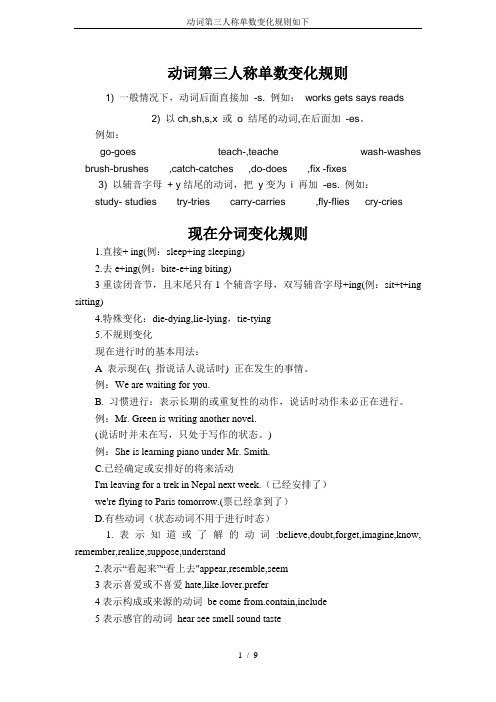
动词第三人称单数变化规则1) 一般情况下,动词后面直接加-s. 例如:works gets says reads2) 以ch,sh,s,x 或o 结尾的动词,在后面加-es。
例如:go-goes teach-,teache wash-washes brush-brushes ,catch-catches ,do-does ,fix -fixes3) 以辅音字母+ y结尾的动词,把y变为i 再加-es. 例如:study- studies try-tries carry-carries ,fly-flies cry-cries现在分词变化规则1.直接+ ing(例:sleep+ing sleeping)2.去e+ing(例:bite-e+ing biting)3重读闭音节,且末尾只有1个辅音字母,双写辅音字母+ing(例:sit+t+ing sitting)4.特殊变化:die-dying,lie-lying,tie-tying5.不规则变化现在进行时的基本用法:A 表示现在( 指说话人说话时) 正在发生的事情。
例:We are waiting for you.B. 习惯进行:表示长期的或重复性的动作,说话时动作未必正在进行。
例:Mr. Green is writing another novel.(说话时并未在写,只处于写作的状态。
)例:She is learning piano under Mr. Smith.C.已经确定或安排好的将来活动I'm leaving for a trek in Nepal next week.(已经安排了)we're flying to Paris tomorrow.(票已经拿到了)D.有些动词(状态动词不用于进行时态)1.表示知道或了解的动词:believe,doubt,forget,imagine,know, remember,realize,suppose,understand2.表示“看起来”“看上去"appear,resemble,seem3表示喜爱或不喜爱hate,like.lover.prefer4表示构成或来源的动词be come from.contain,include5表示感官的动词hear see smell sound taste6表示拥有的动词belong to.need.own .possess.want wish1、现在进行时的构成现在进行时由"be+v-ing"构成。
动词第三人称单数变化规则如下
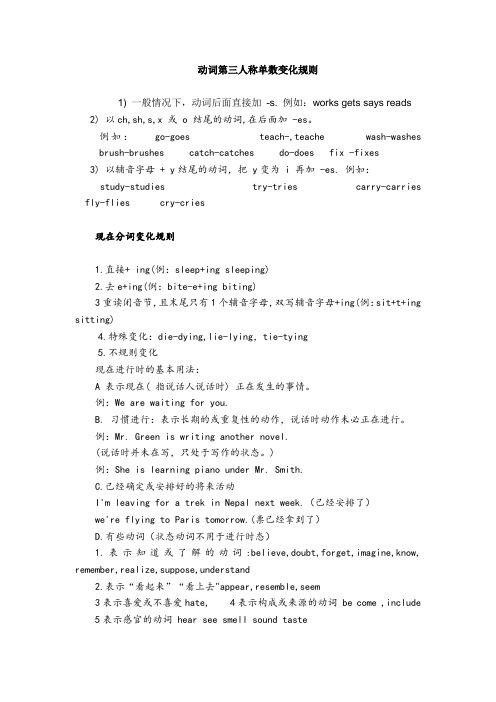
动词第三人称单数变化规则1) 一般情况下,动词后面直接加-s. 例如:works gets says reads2) 以ch,sh,s,x 或 o 结尾的动词,在后面加 -es。
例如:go-goes teach-,teache wash-washes brush-brushes catch-catches do-does fix -fixes3) 以辅音字母 + y结尾的动词,把 y变为 i 再加 -es. 例如:study-studies try-tries carry-carries fly-flies cry-cries现在分词变化规则1.直接+ ing(例:sleep+ing sleeping)2.去e+ing(例:bite-e+ing biting)3重读闭音节,且末尾只有1个辅音字母,双写辅音字母+ing(例:sit+t+ing sitting)4.特殊变化:die-dying,lie-lying,tie-tying5.不规则变化现在进行时的基本用法:A 表示现在( 指说话人说话时) 正在发生的事情。
例:We are waiting for you.B. 习惯进行:表示长期的或重复性的动作,说话时动作未必正在进行。
例:Mr. Green is writing another novel.(说话时并未在写,只处于写作的状态。
)例:She is learning piano under Mr. Smith.C.已经确定或安排好的将来活动I'm leaving for a trek in Nepal next week.(已经安排了)we're flying to Paris tomorrow.(票已经拿到了)D.有些动词(状态动词不用于进行时态)1.表示知道或了解的动词:believe,doubt,forget,imagine,know, remember,realize,suppose,understand2.表示“看起来”“看上去"appear,resemble,seem3表示喜爱或不喜爱hate, 4表示构成或来源的动词 be come ,include 5表示感官的动词 hear see smell sound taste6表示拥有的动词belong . wish1、现在进行时的构成现在进行时由"be+v-ing"构成。
动词第三人称单数变化规则如下
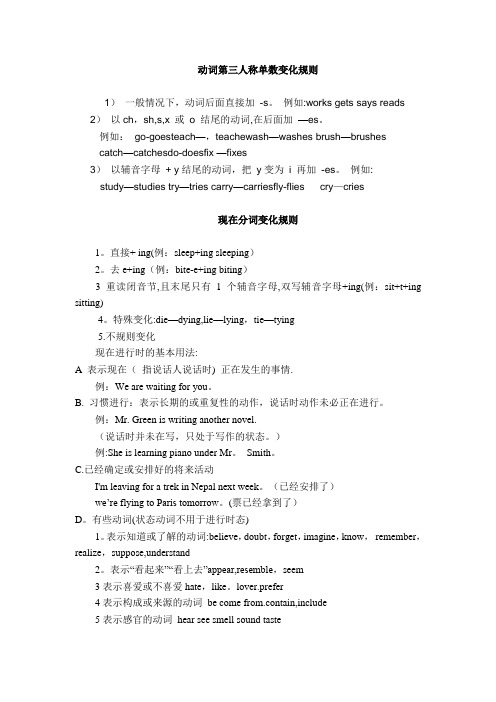
动词第三人称单数变化规则1)一般情况下,动词后面直接加-s。
例如:works gets says reads 2)以ch,sh,s,x 或o 结尾的动词,在后面加—es。
例如: go-goesteach—,teachewash—washes brush—brushescatch—catchesdo-doesfix —fixes3)以辅音字母+ y结尾的动词,把y变为i 再加-es。
例如:study—studies try—tries carry—carriesfly-flies cry—cries现在分词变化规则1。
直接+ ing(例:sleep+ing sleeping)2。
去e+ing(例:bite-e+ing biting)3重读闭音节,且末尾只有1个辅音字母,双写辅音字母+ing(例:sit+t+ing sitting)4。
特殊变化:die—dying,lie—lying,tie—tying5.不规则变化现在进行时的基本用法:A 表示现在(指说话人说话时) 正在发生的事情.例:We are waiting for you。
B. 习惯进行:表示长期的或重复性的动作,说话时动作未必正在进行。
例:Mr. Green is writing another novel.(说话时并未在写,只处于写作的状态。
)例:She is learning piano under Mr。
Smith。
C.已经确定或安排好的将来活动I'm leaving for a trek in Nepal next week。
(已经安排了)we’re flying to Paris tomorrow。
(票已经拿到了)D。
有些动词(状态动词不用于进行时态)1。
表示知道或了解的动词:believe,doubt,forget,imagine,know,remember,realize,suppose,understand2。
表示“看起来”“看上去”appear,resemble,seem3表示喜爱或不喜爱hate,like。
英语动词《第三人称单数形式》的变化规则

英语动词第三人称单数变化规则一般现在时的肯定句中,主语为第三人称单数的动词变化主要体现在词尾的变化上,其规律为:1、变否定句:含有动词第三人称单数形式的句子变否定句时,要在动词前面加上doesn’t 或does not,动词的第三人称单数形式要还原成原形:格式为doesn’t/does not + 动词原形,如:He goes to school at six in the morning. (变否定句)→He doesn't go to school at six in the morning.2、变一般疑问句:把含有动词第三人称单数形式的变成一般疑问句时,要借用助动词does,如:She goes home at five every day.→Does she go home at five every day?--- Yes, she does./No, she doesn’t.哪些主语是第三人称单数?1、人称代词he, she, it;如:He likes watching TV. 他喜欢看电视。
She has lunch at twelve. 她十二点吃午餐。
It looks like a cat. 它看起来像只猫。
2、单个人名、地名或称呼作主语;是第三人称单数。
如:Han Mei looks like her mother. 韩梅看起来像她的母亲。
Beijing is in China. 北京在中国。
Uncle Wang often makes cakes. 王叔叔经常做蛋糕。
3、单数可数名词或this / that / the + 单数可数名词作主语时,是第三人称单数;A horse is a useful animal. 马是有用的动物。
This book is yours. 这本书是你的。
That car is red. 那辆小汽车是红色的。
The cat is Lucy's. 只猫是露茜的。
动词的第三人称单数的变化规律

动词的第三人称单数的变化规律动词,那些语言里跳来跳去的小弹簧,它们可真能折腾人啊,尤其是第三人称单数形式,简直是个迷。
今天,老铁们,就让我来给你们讲讲这些家伙的规矩,一点也不拖泥带水,简明扼要地道来。
1. 基本规律首先咱们得搞明白,动词第三人称单数可不瞎搞。
通常情况下,只要是个普通动词,加个“s”或者“es”就搞定了。
比如,“go”变成“goes”,“eat”变成“eats”,“talk”变成“talks”。
就跟小狗狗只会汪汪叫一样简单,不费吹灰之力。
1.1 以辅音字母结尾的动词哎呀,你要是个以辅音字母结尾的动词,那么加“es”就是你的菜了。
比如,“watch”变成“watches”,“fix”变成“fixes”。
就像是你修车时,扳手一拧,动词也跟着变调儿。
1.2 以“s, x, z, ch, sh”结尾的动词。
这帮家伙比较特殊,它们在变身的时候,也要加上“es”。
所以,“pass”变成“passes”,“fix”变成“fixes”,“buzz”变成“buzzes”,“watch”变成“watches”,“teach”变成“teaches”。
别小看它们,这些字母结尾的动词,变形能力还是相当强的。
2. 特殊变化有些动词,就是那种有点另类的。
它们可不按套路出牌,有自己的一套规矩。
2.1 “y”结尾的动词咱们要说的第一个叛逆小分子就是“y”结尾的动词。
通常情况下,如果前面是辅音字母,就把“y”变成“ies”。
比如,“fly”变成“flies”,“study”变成“studies”。
可如果前面是元音字母,那就直接加“s”就好了,毫不客气地变成“plays”。
2.2 不规则的动词哦对了,总有些动词是不按套路出牌的。
它们就是所谓的不规则动词,就像是那些名媛贵公子,特立独行。
比如,“have”变成“has”,“do”变成“does”,“go”变成“goes”。
它们是语法界的小王子,规则都不太适用,想怎么变就怎么变,谁也拿它们没辙。
英语动词第三人称单数形式的变化规则

英语动词第三人称单数改变规则通常现在时肯定句中,主语为第三人称单数动词改变关键表现在词尾改变上,其规律为:1、变否定句:含有动词第三人称单数形式句子变否定句时,要在动词前面加上doesn’t 或does not,动词第三人称单数形式要还原成原形:格式为doesn’t/does not + 动词原形,如:He goes to school at six in the morning. (变否定句)→He doesn't go to school at six in the morning.2、变通常疑问句:把含有动词第三人称单数形式变成通常疑问句时,要借用助动词does,如:She goes home at five every day.→Does she go home at five every day?--- Yes, she does./No, she doesn’t.3、对划线部分进行提问(变特殊疑问句):通常格式为Whxxx + 通常疑问句?She goes home at five every day. (对划线部分提问)→When/What time does she go home every day?She goes home at five every day. (对划线部分提问)→Who goes home at five every day?She goes home at five every day. (对划线部分提问)→What does she do at five every day?哪些主语是第三人称单数?1、人称代词he, she, it;如:He likes watching TV. 她喜爱看电视。
She has lunch at twelve. 她十二点吃午餐。
It looks like a cat. 它看起来像只猫。
2、单个人名、地名或称呼作主语;是第三人称单数。
动词第三人称单数变化规律
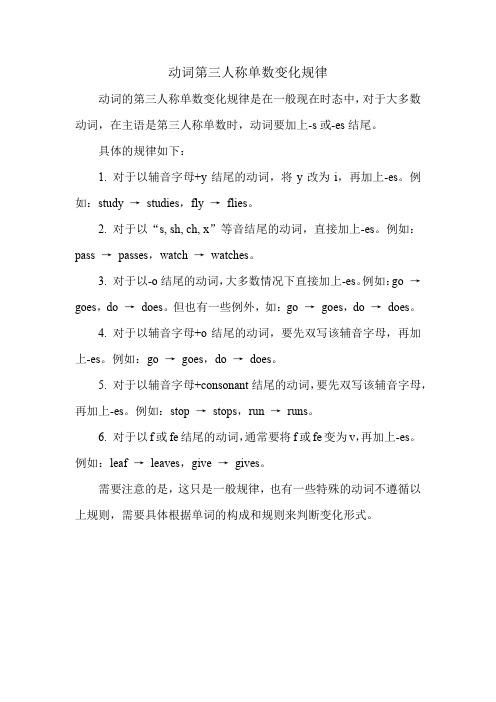
动词第三人称单数变化规律
动词的第三人称单数变化规律是在一般现在时态中,对于大多数动词,在主语是第三人称单数时,动词要加上-s或-es结尾。
具体的规律如下:
1. 对于以辅音字母+y结尾的动词,将y改为i,再加上-es。
例如:study →studies,fly →flies。
2. 对于以“s, sh, ch, x”等音结尾的动词,直接加上-es。
例如:pass →passes,watch →watches。
3. 对于以-o结尾的动词,大多数情况下直接加上-es。
例如:go →goes,do →does。
但也有一些例外,如:go →goes,do →does。
4. 对于以辅音字母+o结尾的动词,要先双写该辅音字母,再加上-es。
例如:go →goes,do →does。
5. 对于以辅音字母+consonant结尾的动词,要先双写该辅音字母,再加上-es。
例如:stop →stops,run →runs。
6. 对于以f或fe结尾的动词,通常要将f或fe变为v,再加上-es。
例如:leaf →leaves,give →gives。
需要注意的是,这只是一般规律,也有一些特殊的动词不遵循以上规则,需要具体根据单词的构成和规则来判断变化形式。
动词第三人称单数变化规则如下

动词第三人称单数变化规则如下高三英语复习动词第三人称单数规则一)一般情况下,动词后面直接加-s.例如:worksgetssaysreads2)以ch、SH、s、x或O结尾的动词,后跟-es。
例如:go goesteach-,teache洗brush-brushes,catch-catches,do-does,fix-fixes3)以辅音字母+y结尾的动词,把y变为i再加-es.例如:study-studiestry-triescarry-carries,fly-fliescry-cries现在分词变化规律1.直接+ing(例:sleep+ingsleeping)2.去e+ing(例:bite-e+ingbiting)3.重读封闭音节,结尾只有一个辅音,并双写辅音+ing(例如sit+T+ingsitting)4.特殊变化:die-dying,lie-lying,tie-tying3.现在分词的变化规则:(1)一般情况下,直接在动词后加-ingwork----workingsleep-----sleepingstudy-----studying(2)这个动词以一个清音的-E结尾。
转到-E并加上-ingtake------take make------make------dancing(3)重读闭音节的动词,要双写词尾字母,再加-ingcut-----cuttingput-----puttingbegin------beginning(4)以-ie结尾的动词改为y并加上-inglie----liengtie-----tyingdie-----dying3.也有一些单音节词可以添加更多和最多,以形成比较级和最高级:最初的比较级和最高级更清晰,最近更新gladmoregladmostglad名词的复数形式构成方法在词尾加-s1.以s、x、sh、ch结尾的名词后加-es2.如词尾是e,只加-s如词尾为cf或cfe,则一般变为cves以辅音+y结尾的名词,变y为i再加-es以元音+y结尾的名词,加-s以辅音+o结尾的名词,加-es以元音+o结尾的名词,加-s以-th结尾的名词,加-s例词英语里有一些名词的复数形式不是以词尾-s或-es构成,构成方法变内部元音foot[u]―feet[i:]man[]―men[e]mouse[au]―mice[ai]woman[]―women[e]词尾加-enox―oxen(公牛)child[ai]―children[i]形式不变(通形名词----单、复数同形)deer―deerfish―fishsheep―sheep集合名词(只有复数,没有单数。
动词第三人称单数变化规则如下
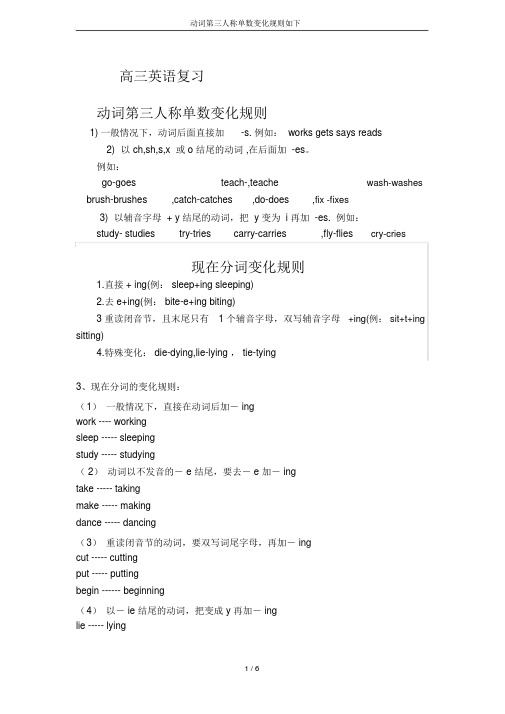
动词第三人称单数变化规则如下高三英语复习动词第三人称单数变化规则1) 一般情况下,动词后面直接加-s. 例如: works gets says reads2)以 ch,sh,s,x 或 o 结尾的动词 ,在后面加 -es。
例如:go-goes teach-,teache wash-washes brush-brushes,catch-catches,do-does,fix -fixes3)以辅音字母 + y 结尾的动词,把 y 变为 i 再加 -es. 例如:study- studies try-tries carry-carries,fly-flies cry-cries现在分词变化规则1.直接 + ing(例: sleep+ing sleeping)2.去 e+ing(例: bite-e+ing biting)3 重读闭音节,且末尾只有 1 个辅音字母,双写辅音字母+ing(例: sit+t+ing sitting)4.特殊变化: die-dying,lie-lying , tie-tying3、现在分词的变化规则:(1)一般情况下,直接在动词后加- ingwork ---- workingsleep ----- sleepingstudy ----- studying( 2)动词以不发音的- e 结尾,要去- e 加- ingtake ----- takingmake ----- makingdance ----- dancing(3)重读闭音节的动词,要双写词尾字母,再加- ingcut ----- cuttingput ----- puttingbegin ------ beginning(4)以- ie 结尾的动词,把变成 y 再加- inglie ----- lyingtie ----- tyingdie ----- dying形容词的比较级和最高级变化形式规则如下构成法原级比较级最高级① 一般单音节词末尾加er和est strong stronger strongest② 单音节词如果以 e 结尾,只加r和strange stranger strangest st③ 闭音节单音节词如末尾只有一个辅音字sad sadder saddest 母,big bigger biggest 须先双写这个辅音字母,再加er和est hot hotter hottest④ 少数以y,er( 或ure),ow,bleangry angrier angrest 结尾的双音节词,末尾加er 和est( 以clever cleverer cleverest y 结尾的词,如y 前是辅音字母,把 y 变成narrow narrower narrowest i ,再加er 和est ,以 e 结尾的词仍加noble nobler noblest r 和st)⑤ 其他双音节和多音节词都在前面加单词different more mostmore 和 most different differentb.其他词都在前面加 more, most 构成比较级及最高级:原级比较级最高级important more important most importantdifficult more difficult most difficultinteresting more interesting most interestinguseful more useful most usefulI.学会下列形容词的比较级和最高级:原级比较级最高级1. tall taller talleststrong stronger strongestold older oldest2. large larger largestfine finer finestlate later latest3. big bigger biggesthot hotter hottestthin thinner thinnest4. easy easier easiestbusy busier busiesthappy happier happiest5. valuable more valuable most valuabledangerous more dangerous most dangerouscomfortable more comfortable most comfortable1.有几个形容词有特殊的比较级和最高级形式:原级比较级最高级good well better bestbad ill worse worstmany much more mostlittle less leastfar farther further farthest furthestold older elder oldest eldest2.双音节词除了以“辅音+ y”结尾的词外,还有以 ow, er, le 结尾的词,和个别其他双音节词,可以用加词尾的办法构成比较级和最高级:原级比较级最高级narrow narrower narrowestclever cleverer cleverestsimple simpler simplestcommon commoner commonest3.也有少数单音节词可以加 more 和 most 的办法构成比较级和最高级:原级比较级最高级pleased more pleased most pleasedtired more tired most tiredglad more glad most glad名词的复数形式构成方法例词在词尾加 -s1.以 s、x、sh、ch 结尾的名词后加 -es2.如词尾是 e,只加 -s如词尾为–f或–fe ,则一般变为–ves以辅音 +y 结尾的名词,变y 为 i 再加 -es以元音 +y 结尾的名词,加-s以辅音 +o 结尾的名词,加-es以元音 +o 结尾的名词,加-s以-th 结尾的名词,加 -s英语里有一些名词的复数形式不是以词尾-s 或-es 构成,例词构成方法变内部元音foot[ u ] — feet[i: ]man[ ] —men[ e ]mouse[ au ]— mice[ ai ]woman[] —women[ e ]词尾加 -en ox— oxen(公牛 )child[ ai ] — children[ i ]形式不变(通形名词 ---- 单、复数同形) deer— deerfish—fishsheep—sheep集合名词trousers people (人,人民)(只有复数,没有单数。
- 1、下载文档前请自行甄别文档内容的完整性,平台不提供额外的编辑、内容补充、找答案等附加服务。
- 2、"仅部分预览"的文档,不可在线预览部分如存在完整性等问题,可反馈申请退款(可完整预览的文档不适用该条件!)。
- 3、如文档侵犯您的权益,请联系客服反馈,我们会尽快为您处理(人工客服工作时间:9:00-18:30)。
动词第三人称单数变化规则1) 一般情况下,动词后面直接加-s. 例如:works gets says reads2) 以ch,sh,s,x 或o 结尾的动词,在后面加-es。
例如:go-goes teach-,teache wash-washes brush-brushes ,catch-catches ,do-does ,fix -fixes3) 以辅音字母+ y结尾的动词,把y变为i 再加-es. 例如:study- studies try-tries carry-carries ,fly-flies cry-cries现在分词变化规则1.直接+ ing(例:sleep+ing sleeping)2.去e+ing(例:bite-e+ing biting)3重读闭音节,且末尾只有1个辅音字母,双写辅音字母+ing(例:sit+t+ing sitting)4.特殊变化:die-dying,lie-lying,tie-tying5.不规则变化现在进行时的基本用法:A 表示现在( 指说话人说话时) 正在发生的事情。
例:We are waiting for you.B. 习惯进行:表示长期的或重复性的动作,说话时动作未必正在进行。
例:Mr. Green is writing another novel.(说话时并未在写,只处于写作的状态。
)例:She is learning piano under Mr. Smith.C.已经确定或安排好的将来活动I'm leaving for a trek in Nepal next week.(已经安排了)we're flying to Paris tomorrow.(票已经拿到了)D.有些动词(状态动词不用于进行时态)1.表示知道或了解的动词:believe,doubt,forget,imagine,know, remember,realize,suppose,understand2.表示―看起来‖―看上去"appear,resemble,seem3表示喜爱或不喜爱hate,like.lover.prefer4表示构成或来源的动词be come from.contain,include5表示感官的动词hear see smell sound taste6表示拥有的动词belong to.need.own .possess.want wish1、现在进行时的构成现在进行时由"be+v-ing"构成。
be应为助动词,最容易被同学漏掉,它应与主语的人称和数保持一致。
2、现在进行时的应用(1)当句子中有now时,常表示动作正在进行,这时要用现在进行时。
如:They are playing basketball now.现在他们正在打篮球。
(2)以look, listen开头的句子,提示我们动作正进行,这时要用现在进行时。
如:Listen!She is singing an English song.听,她正在唱英语歌。
(3)表示当前一段时间或现阶段正在进行的动作,且此时有this week, these days 等时间词,这时常用现在进行时。
如:We are making model planes these days.这些天我们在做飞机模型。
(4)描述图片中的人物的动作,也为了表达更生动。
此时也常用现在进行时。
如:Look at the picture. The children are flying kites in the park.看这幅图,那些孩子正在公园放风筝。
3、现在分词的变化规则:(1)一般情况下,直接在动词后加-ingwork ---- workingsleep ----- sleepingstudy ----- studying(2)动词以不发音的-e结尾,要去-e加-ingtake ----- takingmake ----- makingdance ----- dancing(3)重读闭音节的动词,要双写词尾字母,再加-ingcut ----- cuttingput ----- puttingbegin ------ beginning(4)以-ie结尾的动词,把变成y再加-inglie ----- lyingtie ----- tyingdie ----- dying4、现在进行时的变化肯定句式:主语+be( am, is, are)+现在分词+其它.否定句式:主语+be(am, is, are) +not +现在分词+其它.一般疑问句:be(am, is, are) +主语+现在分词+其它特殊疑问句:疑问词+be(am, is, are)+主语+现在分词+其它little less leastfar farther further farthest furthestold older elder oldest eldest小贴士1:elder和eldest可用来表示兄弟和子女的长幼顺序:my elder sister 我的姐姐my eldest brother 我的大哥their eldest son他们的长子小贴士1:further表示“较远”外,还可表示“进一步的”;而farther 仅表示距离:The farther plants are too cold. 更远的行星太冷。
Do you need any further help? 你还需要更进一步的帮助吗?2. 双音节词除了以“辅音+y”结尾的词外,还有以ow, er, le结尾的词,和个别其他双音节词,可以用加词尾的办法构成比较级和最高级:原级比较级最高级narrow narrower narrowestclever cleverer cleverestsimple simpler simplestcommon commoner commonest3. 也有少数单音节词可以加more和most的办法构成比较级和最高级:原级比较级最高级pleased more pleased most pleasedtired more tired most tiredglad more glad most glad名词的复数形式英语里有一些名词的复数形式不是以词尾-s或-es构成,其它名词复数的规则变化1) 以y结尾的专有名词,或元音字母+y 结尾的名词变复数时,直接加s变复数:如:two Marys the Henrysmonkey---monkeys holiday---holidays比较:层楼:storey ---storeys story---stories2) 以o 结尾的名词,变复数时:a. 加s,如:photo---photos piano---pianosradio---radios zoo---zoos;b. 加es,如:potato--potatoes tomato--tomatoesc. 均可,如:zero---zeros / zeroes3) 以f或fe 结尾的名词变复数时:a. 加s,如:belief---beliefs roof---roofssafe---safes gulf---gulfs;b. 去f,fe 加ves,如:half---halvesknife---knives leaf---leaves wolf---wolveswife---wives life---lives thief---thieves;c. 均可,如:handkerchief:handkerchiefs / handkerchieves名词复数的不规则变化1)child---children foot---feet tooth---teethmouse---mice man---men woman---women注意:与man 和woman构成的合成词,其复数形式也是-men 和-women。
如:an Englishman,two Englishmen. 但German不是合成词,故复数形式为Germans;Bowman是姓,其复数是the Bowmans。
2)单复同形如:deer,sheep,fish,Chinese,Japaneseli,jin,yuan,two li,three mu,four jin但除人民币元、角、分外,美元、英镑、法郎等都有复数形式。
如:a dollar, two dollars; a meter, two meters3)集体名词,以单数形式出现,但实为复数。
如people police cattle 等本身就是复数,不能说 a people,a police,a cattle,但可以说a person,a policeman,a head of cattle,the English,the British,the French,the Chinese,the Japanese,the Swiss 等名词,表示国民总称时,作复数用。
如:The Chinese are industries and brave. 中国人民是勤劳勇敢的。
4)以s结尾,仍为单数的名词,如:a. maths,politics,physics等学科名词,为不可数名词,是单数。
b. news 是不可数名词。
c. the United States,the United Nations 应视为单数。
The United Nations was organized in 1945. 联合国是1945年组建起来的。
d. 以复数形式出现的书名,剧名,报纸,杂志名,也可视为单数。
"The Arabian Nights" is a very interesting story-book.<<一千零一夜>>是一本非常有趣的故事书。
5) 表示由两部分构成的东西,如:glasses (眼镜) trousers, clothes若表达具体数目,要借助数量词pair(对,双); suit(套); a pair of glasses; two pairs of trousers6)另外还有一些名词,其复数形式有时可表示特别意思,如:goods货物,waters 水域,fishes(各种)鱼动词变名词1.在词尾加er,r ,双写加er 或or:A. play _ player, sing _ singer, wait _ waiter , find _ finder,thrill _ thrillerB. write _ writer, drive _ driver, come _ comer, explore _ explorerdance _ dancerC. run _ runner, win _ winner, rob _ robber, traval _ travallerD. visit _ visitor, invent _ inventor2. 在词尾加ing:build _ building, draw _ drawing, end _ ending, begin _ beginning,swim _ swimming,skate _ skating, feel _ feeling, say _ saying,mean _ meaning, cross _ crossing,surf _ surfing, paint _ painting3.在词尾加ion 或去e加ion:A. decide _ decision, describe _ description, produce _ production, celebrate _ celebration,pronounce _ pronunciation, decorate _ decoration graduate _ graduation,frustrate - frustration,pollute _ pollutioncontribute _ contribution, congratulate _ congratulation,educate _ education,organize _ orgnization,donate _ donation, appreciate _ appreciation,operate _ operation, invite _ invitationB. discuss _ discussion, invent _ invention, attract _ attractionimpress _ impression,inject _ injection,instruct _ instruction4.其它:know _ knowledge, please _ pleasure, enjoy _ enjoyment,practise _ practice,die _ death, succeed _ success, weigh _ weight,sit _ deat, change _ chance,enter _ entrance,fly _ flight,rob _ robbery, discover _ discovery,faile _ failure,appear _ appearance, breathe _ breath。
